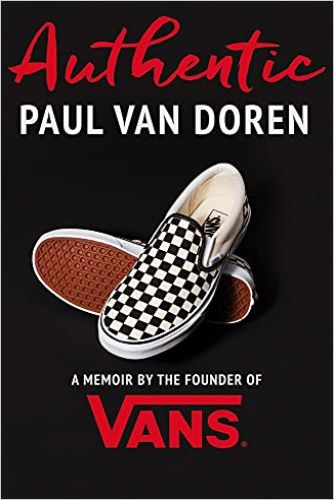In this candid memoir, Vans’ late founder Paul Van Doren explains how he started and sustained Vans Shoes, and how he flexed with the times while always remaining true to his vision.

Keeping It Real
Vans shoes are American icons and the company’s founder, Paul Van Doren, was a legend. In this memoir, published just before his death in 2021, he shares how he and his family built Vans, and how his son Stevie made it the signature shoe of skater and surfer culture. Through good times and bad, Van Doren emphasizes, authenticity and simplicity remained Vans’ hallmarks.
Work Ethic
His parents taught Paul Van Doren that family matters most, especially in difficult times.
If my earliest memories are parables in weighing the odds, my later memories — my favorite ones, at least — are in defying them.
For example, Van Doren tells of taking the calculated risk of promising a distributor one million sparklers from his father’s company by July 3rd. With a $600 investment in materials, his family could make $10,000, a fortune in 1946. His father, shocked at Van Doren’s daring, led the family in making the sparklers on time.
Randy’s Canvas Uppers
After he dropped out of high school, Van Doren took a job at Randolph’s Manufacturing – Randy’s – which made the canvas uppers for Keds sneakers. His first day, Van Doren detected a bottleneck in the assembly line and stayed late to fix it. The line ran perfectly afterward, but Van Doren received no attention or congratulations.
Making canvas shoes was what I knew best. Hell, making canvas shoes was the only thing I knew.
Within a few months, as he rose from service boy to supervisor, Randy’s executives came to dislike Van Doren for – according to his account – knowing their business better than they did.
The Van Doren Rubber Company
Dislike or not, in 1964 Randy’s offered Van Doren the opportunity to supervise Randy’s West, the company’s new plant in Garden Grove, California. He soon learned that people in California wear sneakers year-round. That year, he set up a booth at the US Open of Surfing at Huntington Beach, CA and, in a couple of hours, made custom shoes for surfing legend Duke Kahanamoku. Shortly after, he quit Randy’s.
For me, quitting Randy’s had probably been the biggest stroke of luck in my life. Opportunity is a strange beast.
Van Doren started the Van Doren Rubber Company with $250,000 in 1965. He patented the unusually sticky “waffle” sole, which later made Vans popular with skateboarders. Van Doren kept the merchandise simple, with one shoe style for men, women and kids. He named his brother Jimmy as a partner in the business.
Customized Shoes
Van Doren opened his store, named “House of Van’s,” in March 1966. He learned that mothers make the purchasing choices for their families and that while men were content with a limited range of colors, women preferred variety.
Learning to be flexible in our approach to both manufacturing and selling grew out of our willingness to innovate in order to meet our customers’ needs.
Van Doren offered customized shoes to individuals, schools, clubs and sports teams. He opened 10 stores in the company’s first six months and doubled that in the following three months.
Skater and Surfer Culture
Van Doren favored person-to-person sales, and he refused to sell Vans wholesale to department stores. He bought a booth at the Los Angeles County Fair and – with his then 12-year-old son Stevie as emcee – the venture proved a huge success. Skateboarders, particularly the famous “Z-boys,” endorsed Vans. Their slang phrase – “Off the Wall” – came to characterize Vans’ culture. The personality of the shoe was that of an outsider, a little crazy and not afraid of the unknown.
Skaters in the mid-70s adopted us, and I thank them still four decades later, because they gave us meaning. (Stevie Van Doren)
By the 1970s, with the Z-boys ascendant, Stevie persuaded his dad to give skateboarders free shoes to promote the Vans brand. The shoes evolved with the sport. Renowned skateboarder Tony Alva begged Van’s salespeople to sell one shoe at a time, because skateboarders wear out their rear foot’s shoe faster. The company’s willingness to sell single shoes in different sizes led podiatrists to recommend them to their patients.
Stevie became a skateboarding enthusiast and drove kids to events all over Orange County. Then surfers adopted Vans. In 1977, Van Doren added the iconic “jazz stripe” to the “Old Skool” model, and it became Vans’ signature.
Dangerous Expansion
After 25 years, Paul’s marriage to his wife Dolly ended in 1973. Eight years later, he remarried and retired to pursue his lifelong passion for horse racing. He designated Jimmy to run the company, but soon discovered that had been a big mistake.
The gist is this: with success comes reputation, and with hardship comes character.
In 1982, Vans achieved worldwide visibility when actor Sean Penn wore its black-and-white checked slip-on in the movie Fast Times at Ridgemont High. Sales exploded. Vans expanded into outlets and department stores, and the company’s value doubled.
Jimmy spent money recklessly on advertising, on himself and on expanding the brand to include styles for many sports. Unlike Paul, Jimmy accumulated debt and drove the company to near-bankruptcy. In 1984, Paul came out of retirement to rebuild the company. He vowed to pay off the $12 million in corporate debt Jimmy had accrued. In three years, Vans was solvent again.
Revitalized Vans
In 1987, after saving the company, Paul sold Vans to a conglomerate for $75 million. When the corporation’s board refused to acknowledge his concerns about diluting the brand, he resigned.
Meanwhile, Stevie never stopped connecting to skaters and surfers. In 1994, he founded the Vans Warped Tour, which combined skater culture and music. In its 25-year history, the Warped Tour launched Katy Perry, Green Day, Ice-T and Eminem, among other musicians. It represented everything Stevie believed Vans stood for: affordability, accessibility, resilience and character.
More than anyone else on the planet, myself included, Stevie embodies the spirit, the voice, and the face of Vans’ culture — the expression of its DNA.
By the late 1990s, Vans had lost market share to cheaper competitors. Stevie convinced the company to bring back its “Old Skool” models and checker-board slip-ons. By 2000, Vans had, once again, become a cool brand. In 2004, the VF Corporation fashion conglomerate bought Vans for $400 million, and once again offered customized shoes, as Paul had done in the 1960s. Today, Vans has 18 million Instagram followers because – as Van Doren wrote – the company stayed true to his creed of being authentic and keeping it simple.
Likable Storytelling
Paul Van Doren was a great storyteller, unashamed and at times shameless. He clearly lacked the protective instincts of most CEO memoirists. Writing with a refined, sometimes bitter, sense of humor, he did not shy away from revealing his hard-nosed perceptions and unshakeable faith in his own judgment. Van Doren’s authorial voice is flat-out likable; you will exult in his triumphs and seek his enemies’ downfall. Startup CEOS, especially, and business students will revel in his timeless tactics and his fervent belief in the power of branding. He also offers priceless lessons in building and sustaining a distinctive commercial vision.





